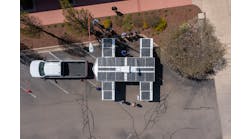Solar, storage and controls are all wrapped into SolPad “personal energy” units soon to be available from SolPad, a startup company that says its units are modular, easy to install and priced lower than the competition.
“The total installed cost for the SolPad Home is up to 50 percent lower than any incumbent, like Tesla’s Powerwall,” said Christopher Estes, SolPad’s co-founder, CEO and chief product architect for SolPad.
The company offers two options: SolPad Mobile, a mobile solar, storage and controls unit that users can expand and use off-grid for a number of applications, including in developing countries, to charge phones and other devices, camping or while renting apartments.
SolPad Home, on the other hand, features the same technology but is more powerful and attaches to homeowners’ roofs, Estes said.
Each SolPad Mobile panel provides 70 watts of solar with 600 watt-hours of lithium-ion storage. The units can be linked together as a microgrid with one plug, potentially providing 6,000 watt-hours of AC power.
Beginning May 3, people can begin pre-ordering SolPad Mobile for an introductory price of $1,395. SolPad will include for free the SolControl Solar Smart Plug (valued at $59.95). Additional SolControls are available for an introductory discount price of $39.95, the company said.
The SolPad Mobile and SolControl units will ship in the second half of 2017.
“In the developing world this has a ton of applications,” said Estes. “You can set up a powerful AC microgrid, literally by just snapping these things together like Legos. People who buy it need it for different things; some people do it as tailgaters, some people live in areas where they have constant power outages and want a clean, renewable backup power solution that’s portable.”
Others might buy it because they are renters and want to use solar to power up their lights, TV or refrigerator, for example.
Estes noted that people don’t have to hand over to utilities control of their energy consumption.
“Energy now is like the Big Brother approach, but it doesn’t have to be. It should be a personal thing, like an iPhone. You plug it in and it works,” he said. “The power is completely in the hands of the user,” he added.
Getting solar power from a roof to a home usually requires wiring, he noted. But the SolPad only requires one cord to get the power into a home. The company’s “bridge” technology will connect a number of the units, which then can be plugged in with one plug.
Power to the user also means that any appliance can be individually powered or controlled using the SolPad, he said. This is accomplished by plugging the units in between household appliances and the power outlets.
“It can be grid-tied for supplemental power,” Estes added. In addition, the units can be programmed to provide power to the grid during peak hours and to charge the batteries during off-peak hours.
“If you want to charge up an array–whether it’s portable or rooftop–at 2 a.m. when electricity is cheap, you can do that,” he said.
To further boost its user-friendliness, the SolPad mobile will talk to users and tell them where to set it up to get the most solar radiation.
What’s more, the system’s control system tells users when an appliance is consuming power and how much it’s using. It can also turn off lights and power down rooms. And it can provide users with information about battery storage levels and energy use for each item, he said.
The units have been tested at SolPad’s headquarters in Mountain View, Calif. The company has given a number of SolPad Mobile demonstrations to reporters and investors at trade shows, Estes said.
Now the Silicon Valley company faces the real-world test in a market dominated by better known names, such as Tesla and Sonnen, as well as several smaller companies vying for market share.
In a cost comparison of residential solar with storage systems, the company said that a 5.3 kW panel with 12.5 kWh of storage capacity costs $31,806 to about $38,407, with the second being a microinverter system with premium AC battery storage, and the first being a power optimizer system with premium DC battery storage. A SolPad Home premium of the same size is estimated to cost about $19,442, but would have a slightly higher power output–8 kW as opposed to 6-6.6 kW, according to company materials.
Interest is running high in residential solar, storage and controls, but pricing remains an obstacle. SolPad may offer a good test of what price point will move homeowners from interest to action.
Track news about the fast-changing market for residential solar, storage and controls. Subscribe to the Microgrid Knowledge newsletter. It’s free.







